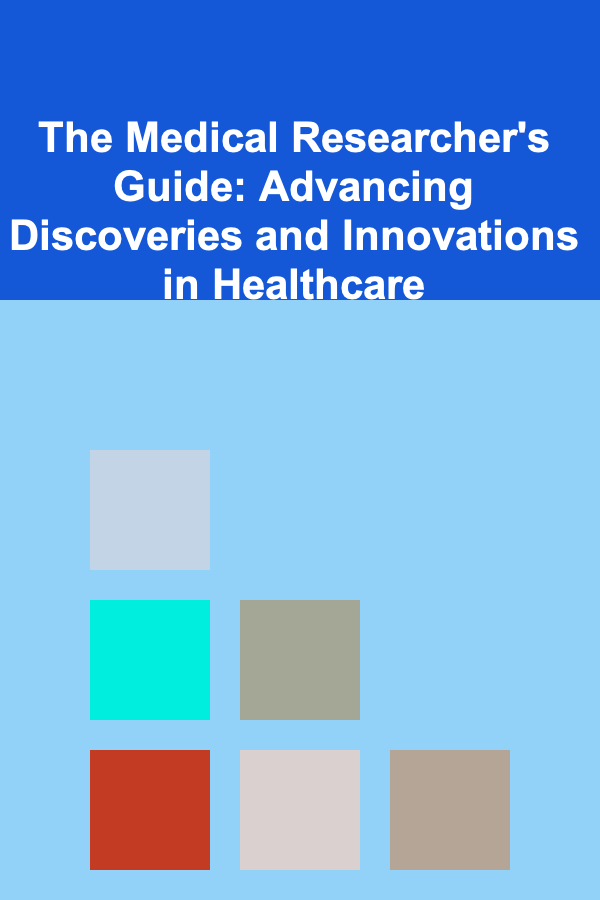
The Medical Researcher's Guide: Advancing Discoveries and Innovations in Healthcare
ebook include PDF & Audio bundle (Micro Guide)
$12.99$8.99
Limited Time Offer! Order within the next:

Medical research is a cornerstone of advancing healthcare. It involves the systematic investigation of medical conditions, treatment methods, drugs, and diagnostic tools to improve patient outcomes. From groundbreaking discoveries to the development of life-saving therapies, medical researchers play a pivotal role in shaping the future of healthcare. This guide delves into the key aspects of medical research, offering actionable steps, insights, and strategies for aspiring and seasoned researchers looking to contribute to the ongoing evolution of healthcare.
The Role of a Medical Researcher
Medical researchers investigate health-related problems with the goal of finding solutions that enhance the understanding of diseases and their treatments. Their work spans basic research, clinical trials, epidemiological studies, and health services research. These researchers work in various settings, including academic institutions, research hospitals, pharmaceutical companies, and government health agencies.
Key Responsibilities of a Medical Researcher:
- Designing Studies: Crafting studies that are scientifically rigorous and ethically sound.
- Collecting Data: Gathering accurate, reliable data through experiments, clinical trials, or observational research.
- Analyzing Data: Employing statistical methods and bioinformatics tools to interpret complex datasets.
- Publishing Findings: Disseminating research results through peer-reviewed journals, conferences, and collaborations.
- Collaboration: Working with interdisciplinary teams, including physicians, biostatisticians, and public health experts, to enhance the research process.
Understanding the nuances of these responsibilities is crucial for maximizing the impact of one's research efforts and ensuring the validity and utility of findings.
Key Areas of Medical Research
Medical research is an expansive field that spans many sub-disciplines. Below are some key areas where researchers are making a significant impact:
1. Basic Medical Research
Basic research lays the foundation for understanding human biology, disease mechanisms, and potential therapeutic targets. This field encompasses molecular biology, genomics, microbiology, and biochemistry.
- Goal: To answer fundamental questions about health and disease at the molecular or cellular level.
- Examples of Research: Investigating genetic mutations linked to inherited diseases, understanding how viruses cause infection, or exploring new pathways for drug development.
2. Clinical Research
Clinical research focuses on understanding the effects of treatments, drugs, and interventions on human populations. This is where new therapies are tested and refined.
- Goal: To improve patient care by translating laboratory findings into clinical practice.
- Examples of Research: Conducting clinical trials to test new cancer therapies, studying the efficacy of vaccines, or comparing different treatment methods for chronic diseases like diabetes.
3. Translational Research
Translational research bridges the gap between basic and clinical research by moving discoveries from the laboratory to the bedside. It aims to accelerate the application of scientific discoveries into real-world healthcare solutions.
- Goal: To translate laboratory findings into new treatment options, drugs, or medical devices that directly benefit patients.
- Examples of Research: Developing a new drug based on a newly discovered biomarker or creating personalized treatment plans based on a patient's genetic profile.
4. Epidemiological Research
Epidemiology involves studying the distribution and determinants of diseases within populations. This area of research helps identify risk factors and develop strategies for disease prevention.
- Goal: To identify causes of diseases, track their spread, and develop strategies for prevention.
- Examples of Research: Studying the impact of lifestyle factors on heart disease or tracking the spread of infectious diseases such as COVID-19.
5. Health Services and Policy Research
This field examines how healthcare systems operate, with a focus on improving accessibility, efficiency, and patient outcomes. It often involves analyzing healthcare policies and their effect on populations.
- Goal: To improve healthcare delivery by examining factors like cost, quality, and access to care.
- Examples of Research: Evaluating the effectiveness of health policies, investigating healthcare disparities, or studying the impact of telemedicine on patient care.
How to Conduct Successful Medical Research
Successful medical research is the product of rigorous planning, execution, and analysis. The following steps outline a strategic approach for advancing discoveries in healthcare.
1. Identify a Research Question
The first step in any research endeavor is identifying a relevant and significant research question. This should address a gap in knowledge and align with current healthcare challenges. An effective research question is specific, measurable, and feasible within the scope of available resources.
- Tip: Focus on questions that can lead to practical solutions or have the potential to improve patient outcomes.
2. Develop a Hypothesis
Once a research question is formulated, the next step is to develop a hypothesis. A hypothesis is a testable prediction based on existing knowledge that provides direction to the research process.
- Example: A researcher may hypothesize that a certain drug can reduce the progression of Alzheimer's disease based on preliminary findings from laboratory studies.
3. Design the Study
Study design is critical for obtaining valid and reliable results. The design will depend on the research question and hypothesis. Common types of studies include randomized controlled trials (RCTs), cohort studies, case-control studies, and laboratory experiments.
- Tip: Ensure that the study design controls for confounding variables and biases, ensuring the results are as accurate and reproducible as possible.
4. Obtain Ethical Approval
Medical research involving human subjects must adhere to ethical guidelines. Institutional Review Boards (IRBs) or ethics committees evaluate the risks and benefits of the research to ensure participants' rights and safety are protected.
- Tip: Always prioritize patient safety and informed consent when designing clinical research involving human participants.
5. Data Collection and Analysis
Data collection is the core of medical research. It involves gathering information systematically and consistently. Afterward, statistical tools are used to analyze the data and draw conclusions.
- Tip: Utilize robust software such as SPSS, R, or Python for data analysis, and ensure your dataset is large enough to yield statistically significant results.
6. Interpret Results
Once the data is analyzed, researchers must interpret the findings. This involves determining whether the hypothesis was supported or refuted and understanding the broader implications for healthcare.
- Tip: Interpret results in the context of existing research, and be cautious of overgeneralizing findings.
7. Disseminate Findings
Sharing research findings is a crucial aspect of the scientific process. Publish results in peer-reviewed journals, present at conferences, and collaborate with other researchers to maximize the impact of the work.
- Tip: Be transparent about your methods and findings, and acknowledge any limitations to ensure the research can be replicated or built upon by others.
Tools and Technologies for Medical Researchers
Advancements in technology are reshaping medical research, providing researchers with powerful tools to accelerate discoveries and enhance the precision of their work. Here are some essential tools for medical researchers:
1. Genomic Technologies
Genomic research is rapidly advancing due to innovations in DNA sequencing and bioinformatics tools. Tools like next-generation sequencing (NGS) allow researchers to study genes in unprecedented detail, providing insights into genetic disorders, cancer, and personalized medicine.
2. Clinical Trial Management Software (CTMS)
Clinical trial management software helps streamline the complex process of running clinical trials, including patient recruitment, data management, and regulatory compliance.
- Examples: Medidata, Oracle's Siebel CTMS, and Veeva Vault QMS.
3. Bioinformatics Platforms
Bioinformatics platforms such as GeneSpring, BioGRID, and Bioconductor allow researchers to analyze large datasets, identify biological patterns, and model complex biological systems.
4. Data Visualization Tools
Data visualization tools help researchers present complex data in an easily digestible format, making it easier to communicate findings to stakeholders, clinicians, or policymakers.
- Examples: Tableau, R (ggplot2), and Python (Matplotlib, Seaborn).
5. Collaboration Tools
Medical research often involves collaboration across teams and institutions. Tools like Slack, Zoom, and Google Drive facilitate communication and data sharing, enabling real-time collaboration on research projects.
Challenges in Medical Research
While medical research holds immense promise, it also faces several challenges that researchers must navigate:
1. Funding Limitations
Securing adequate funding is one of the biggest challenges for researchers. Grants from government agencies, nonprofit organizations, and private industry are crucial for supporting research efforts.
- Solution: Diversify funding sources, collaborate with industry partners, and apply for multiple grants to ensure financial stability for research projects.
2. Ethical and Regulatory Hurdles
Medical research, especially clinical trials, is subject to stringent ethical and regulatory requirements. Navigating these regulations can be time-consuming and complex.
- Solution: Work closely with ethics committees and regulatory bodies to ensure compliance with all applicable laws and guidelines.
3. Data Management
Handling large datasets, especially in genomic or clinical trials, can be overwhelming. Proper data management, including storage, security, and analysis, is essential to maintain the integrity of the research.
- Solution: Invest in cloud-based storage solutions, adopt data-sharing protocols, and utilize advanced data analysis tools to manage and analyze large volumes of data.
4. Translating Research into Practice
Bridging the gap between research findings and practical application in clinical settings is a significant challenge. Translational research is crucial to ensure that discoveries benefit patients in the real world.
- Solution: Foster collaboration between researchers, healthcare providers, and policymakers to facilitate the translation of research into clinical practice.
Conclusion
Medical research is a dynamic and essential field that drives progress in healthcare. By following a systematic and strategic approach, medical researchers can contribute to groundbreaking discoveries that improve patient care, shape healthcare policies, and enhance global health outcomes. By overcoming challenges, adopting innovative technologies, and working collaboratively, researchers can continue to push the boundaries of medical knowledge, ultimately advancing healthcare for generations to come.
Reading More From Our Other Websites
- [Home Renovating 101] How to Replace an Old HVAC System: What You Need to Know
- [Personal Care Tips 101] How to Use a Face Mask to Reduce Acne
- [Home Maintenance 101] How to Maintain Your Home's Insulation to Save Energy
- [Personal Finance Management 101] How to Save Money on Your Monthly Bills
- [Personal Care Tips 101] How to Keep Your Nails and Cuticles Looking Fresh with Daily Oil Use
- [Ziplining Tip 101] How to Capture Thrilling First‑Person Zipline Videos with a GoPro
- [Organization Tip 101] Best Organization Tools for Cleaning and Decluttering
- [Home Budget 101] How to Make a Home Budget When You're Living Paycheck to Paycheck
- [Home Renovating 101] How to Choose the Latest Kitchen Appliance Trends for Your Renovation
- [Home Security 101] How to Burglar-Proof Your Sliding Glass Doors

DIY Pet Toys and Accessories: Creative Ideas to Keep Your Pet Entertained
Read More
How to Make Money Online as a Tea Sommelier: 10 Actionable Ideas
Read More
How to Maximize Closet Storage with Simple DIY Hacks
Read More
How to Save for a Home Renovation While Sticking to a Budget
Read More
How to Take Advantage of Rebates and Incentives for Big Discounts
Read More
How to Become a Space Engineer: A Comprehensive Guide
Read MoreOther Products

DIY Pet Toys and Accessories: Creative Ideas to Keep Your Pet Entertained
Read More
How to Make Money Online as a Tea Sommelier: 10 Actionable Ideas
Read More
How to Maximize Closet Storage with Simple DIY Hacks
Read More
How to Save for a Home Renovation While Sticking to a Budget
Read More
How to Take Advantage of Rebates and Incentives for Big Discounts
Read More